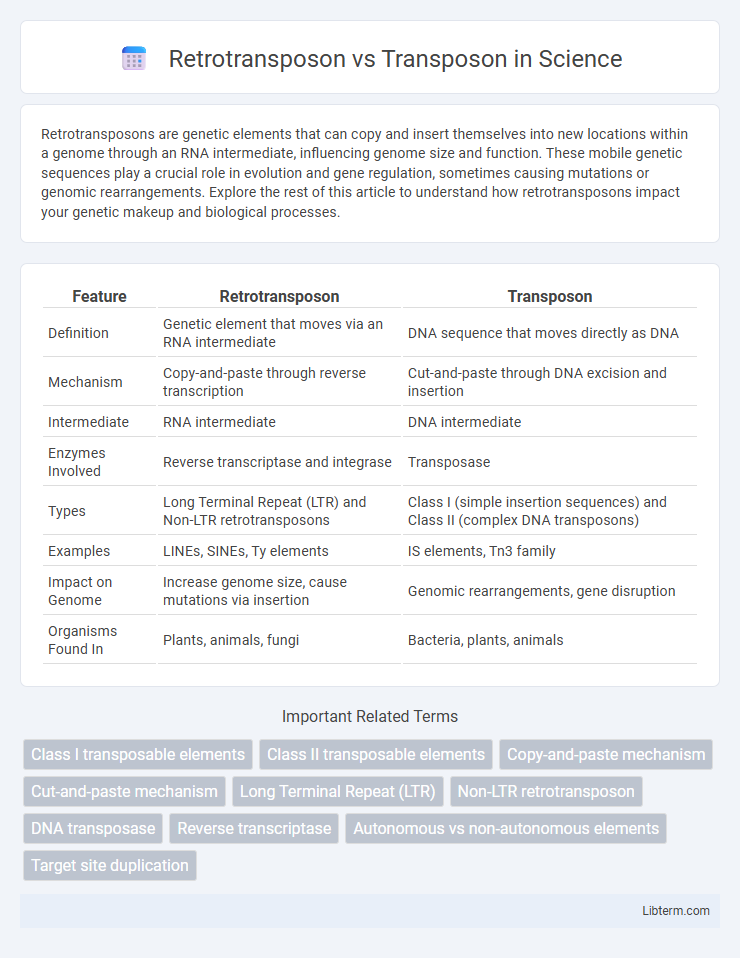Retrotransposons are genetic elements that can copy and insert themselves into new locations within a genome through an RNA intermediate, influencing genome size and function. These mobile genetic sequences play a crucial role in evolution and gene regulation, sometimes causing mutations or genomic rearrangements. Explore the rest of this article to understand how retrotransposons impact your genetic makeup and biological processes.
Table of Comparison
| Feature | Retrotransposon | Transposon |
|---|---|---|
| Definition | Genetic element that moves via an RNA intermediate | DNA sequence that moves directly as DNA |
| Mechanism | Copy-and-paste through reverse transcription | Cut-and-paste through DNA excision and insertion |
| Intermediate | RNA intermediate | DNA intermediate |
| Enzymes Involved | Reverse transcriptase and integrase | Transposase |
| Types | Long Terminal Repeat (LTR) and Non-LTR retrotransposons | Class I (simple insertion sequences) and Class II (complex DNA transposons) |
| Examples | LINEs, SINEs, Ty elements | IS elements, Tn3 family |
| Impact on Genome | Increase genome size, cause mutations via insertion | Genomic rearrangements, gene disruption |
| Organisms Found In | Plants, animals, fungi | Bacteria, plants, animals |
Introduction to Mobile Genetic Elements
Retrotransposons and transposons are key types of mobile genetic elements that enable DNA segments to move within a genome, influencing genetic diversity and evolution. Retrotransposons replicate through an RNA intermediate by reverse transcription, while transposons move directly as DNA without an RNA intermediate. Both elements contribute to genome rearrangements, gene disruption, and the regulation of gene expression in various organisms.
What Are Transposons?
Transposons, also known as "jumping genes," are DNA sequences that can move or transpose themselves to new positions within the genome, facilitating genetic variation and evolution. Retrotransposons are a subclass of transposons that transpose through an RNA intermediate using a "copy and paste" mechanism involving reverse transcription, whereas DNA transposons move via a "cut and paste" mechanism directly at the DNA level. Both types play critical roles in genome dynamics, but retrotransposons contribute significantly to genome size expansion due to their replicative transposition.
Types of Transposons: Class I vs Class II
Transposons are mobile genetic elements classified into two main types: Class I (retrotransposons) and Class II (DNA transposons). Class I retrotransposons move via an RNA intermediate using a "copy-and-paste" mechanism involving reverse transcription, commonly found in eukaryotic genomes and categorized into Long Terminal Repeat (LTR) and non-LTR retrotransposons. Class II DNA transposons operate through a "cut-and-paste" mechanism, directly excising and reinserting DNA segments, and are widespread across prokaryotes and eukaryotes, often encoding transposase enzymes for mobility.
Defining Retrotransposons
Retrotransposons are genetic elements that replicate through an RNA intermediate using reverse transcriptase, integrating back into the genome via a "copy and paste" mechanism. Unlike transposons, which move directly as DNA via a "cut and paste" method, retrotransposons increase their copy number within the genome. They constitute a significant portion of eukaryotic genomes and play crucial roles in genome evolution and regulation.
Mechanisms of Mobilization: Copy-and-Paste vs Cut-and-Paste
Retrotransposons mobilize via a copy-and-paste mechanism, where an RNA intermediate is reverse-transcribed into DNA and inserted at a new genomic location, increasing copy number. Transposons employ a cut-and-paste mechanism, excising the DNA element from one site and integrating it directly into another without replication. The distinct mobilization strategies impact genome stability and evolution by either amplifying genetic elements or relocating them without altering copy number.
Structural Differences: Retrotransposons vs Transposons
Retrotransposons possess long terminal repeats (LTRs) or non-LTR structures and replicate via an RNA intermediate using reverse transcriptase, while transposons typically lack these features and move directly through a DNA intermediate. Structurally, retrotransposons resemble retroviruses with coding sequences for gag and pol proteins, including integrase, whereas transposons contain terminal inverted repeats (TIRs) and encode a transposase enzyme facilitating cut-and-paste or replicative DNA transposition. The presence of reverse transcriptase and RNA intermediate defines the unique structural framework of retrotransposons compared to the simple DNA-based architecture of classical transposons.
Genomic Impact and Functions
Retrotransposons and transposons both contribute to genomic plasticity by facilitating DNA movement within the genome, with retrotransposons copying themselves via an RNA intermediate and reverse transcription, leading to increased genome size. Transposons, or DNA transposons, mobilize through a cut-and-paste mechanism without RNA intermediates, often causing gene disruptions or regulatory changes. Their activities drive genomic innovation, influence gene expression, and generate genetic diversity by creating mutations, altering chromosomal structures, and reshaping regulatory networks.
Evolutionary Significance and Diversity
Retrotransposons and transposons are mobile genetic elements that drive genome evolution by promoting genetic diversity and innovation. Retrotransposons replicate through an RNA intermediate using reverse transcriptase, contributing to genome size expansion and regulatory network modulation, while DNA transposons excise and reinsert directly, facilitating gene shuffling and chromosomal rearrangements. The evolutionary significance of both lies in their capacity to generate mutations, create new genes, and impact genome plasticity across diverse species, reflecting their critical role in adaptive evolution and speciation.
Applications in Genetics and Biotechnology
Retrotransposons serve as valuable tools in genetic research by enabling the study of gene function through insertional mutagenesis and facilitating genome mapping due to their ability to copy and insert themselves via an RNA intermediate. Transposons, also known as "jumping genes," are extensively utilized in biotechnology for gene tagging, mutagenesis, and the development of transgenic organisms because they move directly through a DNA intermediate. Both elements contribute to genome engineering techniques, but retrotransposons are particularly prominent in studying evolutionary genetics, while transposons are preferred for targeted gene delivery and editing applications.
Summary: Key Differences Between Retrotransposons and Transposons
Retrotransposons transpose through an RNA intermediate using reverse transcriptase, whereas transposons move directly as DNA segments through a "cut-and-paste" or "copy-and-paste" mechanism. Retrotransposons increase genome size by duplicating themselves, while DNA transposons typically relocate without increasing copy number. These distinct mechanisms influence genome evolution and variability differently across organisms.
Retrotransposon Infographic

 libterm.com
libterm.com